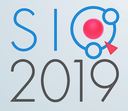Executive Secretary

7th International Chemistry Symposium
SIQ 2019
The glycolipids carrying the antigenic determinant Lewis Y are potential candidates for the development of therapeutic vaccines against different types of cancer. The main problem with Lewis Y synthesis is the α-difucosylation of a lactosamine acceptor with an L-fucose donor. To perform this reaction, one of the best options is the O-(2-O-benzyl-3,4-di-O-acetyl-α/β-L-fucopyranosyl)-trichloroacetoimidate because it provides a high stereoselectivity. However, the reported method to synthesize this fucose donor has the drawback that very low yields are obtained (20-24%), due to the formation of large amounts of mixed 2-O-acetal during the isopropiliden protection of C-3 and C-4 positions. In the present work, a new and efficient synthetic route to prepare the trichloroacetoimidate donor mentioned above was developed. The synthetic sequence used was as follows: one step L-fucose per-O-acetylation and glycosylation with thiophenol to synthetize the per-O-acetylated thioglycoside, thioglycoside des-O-acetylation, 3 and 4 hydroxyl protection with the benzylidene group, 2-hydroxyl group benzylation, benzylidene protective group cleavage, free hydroxyl groups acetylation, anomeric thiophenyl group elimination to obtain the corresponding hemiacetal and finally, the introduction of trichloroacetimidate group. The overall yield of trichloroacetoimidate was about 70 %, it means three times higher than the obtained according to the method described in the literature.
The glycolipids carrying the antigenic determinant Lewis Y are potential candidates for the development of therapeutic vaccines against different types of cancer. The main problem with Lewis Y synthesis is the α-difucosylation of a lactosamine acceptor with an L-fucose donor. To perform this reaction, one of the best options is the O-(2-O-benzyl-3,4-di-O-acetyl-α/β-L-fucopyranosyl)-trichloroacetoimidate because it provides a high stereoselectivity. However, the reported method to synthesize this fucose donor has the drawback that very low yields are obtained (20-24%), due to the formation of large amounts of mixed 2-O-acetal during the isopropiliden protection of C-3 and C-4 positions. In the present work, a new and efficient synthetic route to prepare the trichloroacetoimidate donor mentioned above was developed. The synthetic sequence used was as follows: one step L-fucose per-O-acetylation and glycosylation with thiophenol to synthetize the per-O-acetylated thioglycoside, thioglycoside des-O-acetylation, 3 and 4 hydroxyl protection with the benzylidene group, 2-hydroxyl group benzylation, benzylidene protective group cleavage, free hydroxyl groups acetylation, anomeric thiophenyl group elimination to obtain the corresponding hemiacetal and finally, the introduction of trichloroacetimidate group. The overall yield of trichloroacetoimidate was about 70 %, it means three times higher than the obtained according to the method described in the literature.
About The Speaker

Lic. Yuleidys de Las Mercedes Iglesias Morales






